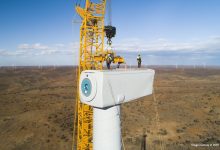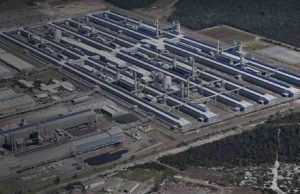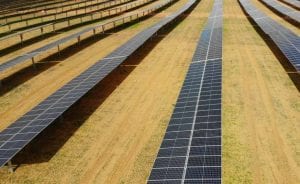The state of New South Wales remains highly dependent on coal-fired generation – 75 per cent in the last year – but its energy minister believes that it can become a renewable energy superpower, and through that an economic superpower as well.
“We have some of the best renewable resources you’ll find anywhere on the planet,” Matt Kean tells RenewEconomy in the latest episode of the weekly Energy Insiders podcast. “We’ve got great sun. We’ve got great wind. And guess what? We’ve got the ability to have a lot of pumped hydro.
“So we’re well placed to be an energy superpower. The flow on effect from that means cheaper bills for consumers. Cheaper bills for business (and) more opportunities here. And the creation of jobs with businesses that are energy intensive.
“If they’re looking for a global competitive advantage when it comes to low cost energy, we can provide it, but we’ve got to move quickly and we’ve got to move now. And that is an opportunity for us to be an economic superpower, not just an energy superpower, an economic superpower. And it’s too big an opportunity not to grab.”
It’s a theme that is catching on in the conservative side of politics in Australia, not that you’d notice from reading the mainstream media.
Kean, of course, is a Liberal MP in the conservative Berejiklian government in NSW, and his views are shared by the Tasmania Liberal government, which has an aim of reaching 200 per cent renewables within 20 years so it can export the surplus to the mainland, or attract clean industries to its state; and the South Australia Liberal government, which wants to reach net 100 per cent renewables by 2030, and also become a renewable export superpower, exporting to neighbouring states and other countries.
It’s not something that you hear much about in the federal Coalition, or even the Liberal and LNP state oppositions in Victoria and Queensland, but Kean says you simply can’t ignore the science, and you can’t ignore global trends.
“The world is moving in this direction. Fifty three per cent of the world’s GDP has signed up to achieve zero net emissions by 2050. So it’s only going in one direction,” Kean says.
“You’d imagine if the Democrats take the White House, then that final domino will fall and it will turbo-charge the world’s move towards zero emissions.We’ve got two choices here, as far as I can see. We can set ourselves up for success …. be a prosperous nation where jobs are created here domestically and our wealth is created here domestically, or we can stick our head in the sand, ignore the global reality that is occurring.
“As far as I’m concerned, there is only one way to go, and that is to modernise the grid, deliver cheap, reliable energy and set ourselves up to be an energy and economic superpower in a low carbon economy.”

NSW, it should be noted, is the only state in the National Electricity Market that does not have a state-based renewables target (200 per cent in Tasmania, 100 per cent in South Australia by 2030, and 50 per cent in Victoria and Queensland by 2030) but by a quirk of fate it will likely experience as speedy a transition to clean energy as the others.
Change will be thrust upon it because its coal fired generators are getting old and will close soon – Liddell in 2023, Vales Point and Eraring by around 2030, Bayswater in 2036 and Mt Piper – if it can find any coal – might extend out to 2040.
NSW, after a slow start that has seen deployment in other states take most advantage of the renewable energy target, is trying to catch up by becoming the first to create renewable energy zones, purpose-built regions with enough infrastructure to ensure that large amounts of wind, solar and storage can be accommodated in the local grid, and which can attract new industry.
Kean’s first hurdle is negotiating the closure of Liddell, currently scheduled for 2023. But the federal government is keen for it, and all coal generators, to stay open for as long as possible, and pushed the NSW government into creating a “joint Liddell task force” to consider its options, and test the case for grid security.
Kean appears to have come down on the side of Liddell owners AGL, noting that the coal plant is very old, very unreliable, and keeping it online may pose risks to worker safety and grid reliability.
“I’ve got serious concerns about a proposed extension of Liddell, particularly around worker safety. We know this is an ageing bit of kit,” Kean says.
“And as the former World Health and safety minister in New South Wales, I don’t want to say anything that would put our, you know, our electricity workers or any workers, for that matter, in harm’s way.
“Everyone should be able to go to work in the morning and come home safe with their families at night. So I don’t want to say an extension if it’s going to put workers safety in harm’s way. The other thing I want to say is reliable electricity for the businesses and families of New South Wales and an extension of Liddell. If that can’t guarantee reliability of the system, then I’ve got serious concerns about the extension.
“We know, Giles, that last summer, every day there was a hot day I’d have to go out embarrassedly (asking people) to turn off their air conditioners, not because of the renewables in the system, but because the existing coal fired generators that we have relied on for so long.
“Did it work when we needed them to work? Ladell has a nameplate capacity of about 1,600 megawatts on a good day. I can only rely on about half of that capacity being generated out of the system. So what we need to do is focus on ensuring that we replace existing generators when they come to their end of their lives with with technology that will provide that cheap, reliable energy.
“And we know from the work of the CSIRO and AEMO (the Australian Energy Market Operator) that the cheapest form of reliable electricity today is a combination of wind, solar, batteries and pumped hydro.
“The benefit of those technologies that they’re not only cheap and reliable, they’re also cleaner. And as we head towards a low carbon global economy, we have an opportunity to get ahead of the pack, set ourselves up to be a major player in that space with low cost, reliable, clean electricity as we head towards net zero emissions.”
Kean would not comment on the conclusions of the Liddell inquiry, but said it was completed and it was up to federal energy minister Angus Taylor to release it. But Kean is also aware of the politics of coal, which is about the dirty mineral’s only remaining ally given it is losing out on economics, environment, and engineering.
“The coal industry plays an important role in our economy. But let’s let’s not let ideology get in the way of good policy. Let’s not let misinformation get in the way of the facts. The reality is the use of domestic coal is only very small.
“It’s less than eight per cent of the jobs in New South Wales related to the coal industry. So we know that the technologies that rely on coal to produce electricity are all technologies and that there are newer technologies that will deliver cheaper, more reliable forms of electricity to the people of New South Wales.
“So I’m not going to have ideology get in the way of decision making processes. I want to make decisions based on the economics, based on the science and based on the facts. And that’s why we’re moving towards new technologies and transitioning our grids by building these renewable energy. And not because of ideology, because that’s what the science that’s what the economic side will deliver.”
As the grid transitions, Kean says he is aware of the need to transform the transport sector too, and has taken one small step along that road by becoming the first minister in Australia to choose a Tesla Model 3 as his ministerial car. He says it is cheaper (over the term of the lease), cleaner, and a lot more fun than the petrol options. “It’s the best car I’ve ever driven,” he says.
See our story on that on our EV-focused sister site, The Driven: “Best car I’ve every driven:” NSW energy minister chooses Model 3 as new ministerial car.
Kean is not directly responsible for EV policy – that is the purview of transport minister Andrew Constance, but says the government has “a number of levers” that will seek to ensure that the system is ready for the growth of EVs.
“We’re setting up a competitive process to build a charging infrastructure across New South Wales. It’s a bit of chicken and egg. But, you know, people won’t take up an EV if they don’t have confidence that there will be other charging stations as they’re driving about Sydney or indeed across the state.
“We’re setting up a competitive process for to encourage fleets to upgrade to electric, to give the market more choices and more models to suit particular dates. If you get fleet buyers, there are big purchases of vehicles. That means that you catalyse the secondary market, making the price point lower for those people that want to get into the market.
“We’ve increased the government fleet purchase target to 30 per cent electric…. so we’ve got a number of systems and processes and policies in place to encourage the uptake of a base. But it all comes back to the single source of truth that is cheap, reliable, clean energy, which is exactly why we’re transitioning our grid.”








